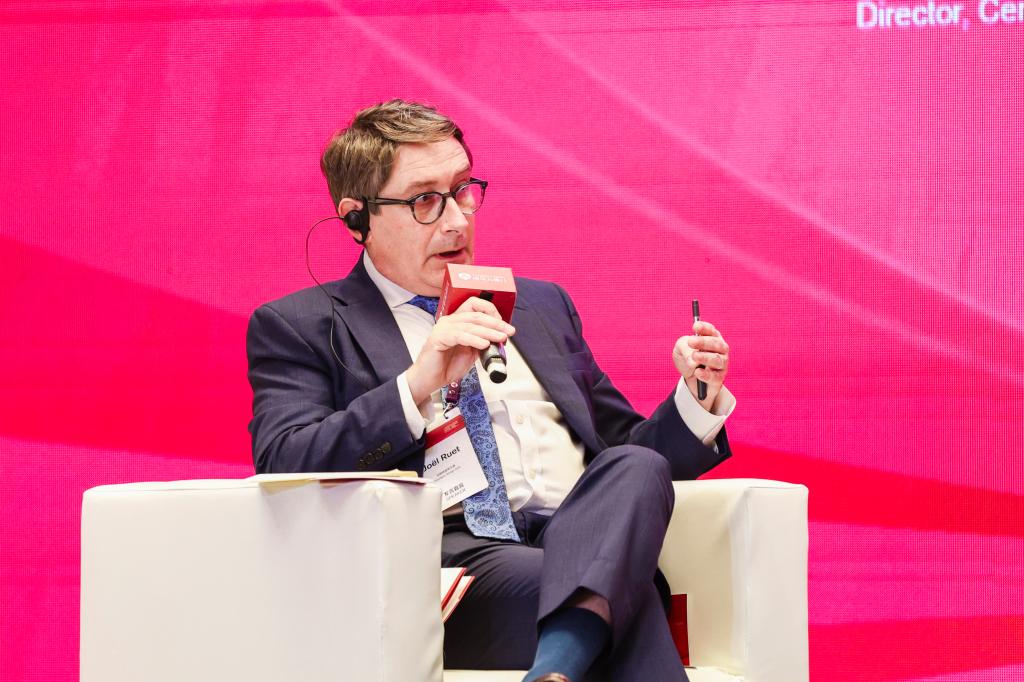On the afternoon of May 17, 2025, the fifth theme session of the 2025 Tsinghua PBCSF Global Finance Forum, titled “Opportunities and Challenges of Green Development,” was held at the Shenzhen, bringing together global leaders to address the pressing issues of climate finance and sustainable transition. Distinguished speakers included Ju Jiandong, Chair Professor and Director of the Green Finance Research Center at Tsinghua PBCSF; Luiz Pereira da Silva, Former Deputy Governor of the Central Bank of Brazil and ex-Deputy General Manager of the Bank for International Settlements (BIS); Liu Meng, China Representative of the UN Global Compact; and Hamed Semega, Former Minister of Mines, Energy, and Water of Mali.
The session was moderated by Joël Ruet, Chairman of the Bridge Think.

Photo: Ju Jiandong Highlights Climate Urgency and South-South Collaboration
Ju Jiandong opened the session with a stark warning: global temperatures have already risen by 1.5°C, and without immediate action, a catastrophic 4°C increase by 2060 is inevitable. He proposed three main suggestions: first, leveraging South-South cooperation to offset the decline in developed countries' green demand, with China taking the lead; second, governments should establish guarantee mechanisms to ensure the return rate of green project investments and attract international capital; third, promoting collaboration between multilateral development banks and emerging markets to address the mismatch in green energy supply and demand.
He emphasized that against the backdrop of declining green demand in developed countries, China needs to lead the formation of positive demand in emerging markets through South-South cooperation. Taking African green electricity projects as an example, he suggested that governments should guarantee an annual return rate of 3%-4% to attract international capital. Regarding the energy supply-demand mismatch, he recommended focusing on critical links such as power grid construction and resolving bottlenecks through targeted fiscal interventions. In addition, he called for cooperation between the BRICS Development Bank and the World Bank to innovate financing tools like "sovereign guarantees + multilateral backstops", transforming Africa's natural resources such as gold into sustainable collateral. Finally, using African solar energy projects as an example, he stressed that "green finance is still finance at its core, and profitability is a prerequisite for private sector participation".

Photo: Luiz Pereira da Silva Advocates Systemic Reforms in Green Financing
Luiz Pereira da Silva underscored the need for international organizations to bridge funding gaps and de-risk investments in emerging markets. He stressed the importance of expanding guarantees through institutions like the BIS, which could boost green bond issuance by 30% while aligning with Basel III standards. Da Silva also highlighted the potential of AI and blockchain to streamline loan approvals for small-scale projects in regions like Sub-Saharan Africa. “The key is to blend public guarantees with private capital,” he said, urging increased capital allocations to multilateral development banks to absorb climate risks. He further advocated integrating carbon emissions as a non-negotiable criterion in loan approvals and embedding ESG ratings into bond structures to enhance transparency.

Photo: Liu Meng Charts ESG’s Evolution and Market Integration
Liu Meng traced the origins of ESG principles to the UN Global Compact’s 2006 framework, now adopted by 25,000 companies globally. She highlighted China’s strides in renewable energy, driven by policy incentives and green loans, while calling for deeper integration of circular economy models. “Enterprises need subsidized loans to scale innovations like RPET plastic recycling,” she noted, pointing to cost barriers faced by companies. Liu also revealed Shanghai’s pilot “responsible metal pricing” initiative, which embeds ESG metrics into the valuation of lithium and cobalt—a move poised to reshape global supply chains. She emphasized the need for alignment between China’s Belt and Road Initiative and the EU’s Global Gateway to harmonize climate-resilient infrastructure standards, ensuring equitable transitions across regions.

Photo: Hamed Semega Demands Equity in African Green Transitions
Hamed Semega delivered a passionate critique of global green finance rules, labeling them “unfair” for sidelining African projects despite their climate impact. He detailed Mali’s energy crisis, where solar power—cheaper than fossil fuels—remains underutilized due to grid deficiencies. Semega urged “leapfrog development” through partnerships with China to deploy smart grids and green hydrogen systems, bypassing outdated infrastructure. Highlighting the Senegal River Basin’s success, where four dams were built in five years with Chinese support, he called for securitizing carbon credits into “climate resilience bonds” to attract multilateral funding. “Solidarity, not charity, will drive Africa’s progress,” he asserted, criticizing debt traps that stifle growth in resource-rich nations.

Photo: Joël Ruet Calls for Global Solidarity and Patient Capital
In his closing remarks, Joël Ruet emphasized the need to balance profit motives with social equity, urging financial systems to convert Africa’s gold and lithium reserves into tradable green assets. He proposed an AIIB-style fund to support “patient capital” for Africa’s energy transitions, ensuring long-term investments align with climate goals. Joël also announced the forum’s key deliverables, including the Green Finance South-South Cooperation Index and Climate-Resilient Infrastructure White Paper, to be published via the “PBC Green Insights” platform.